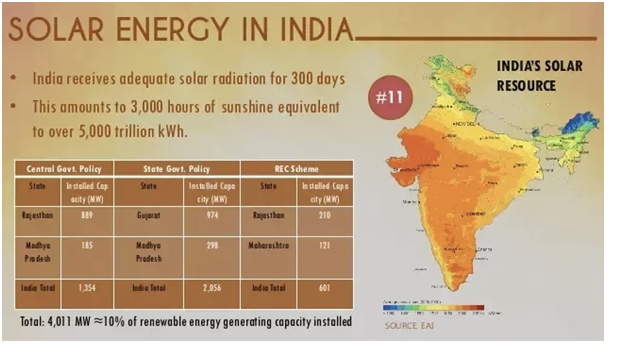An energy conundrum: On India betting big on solar power
With a rapidly expanding population and economy, India faces a significant problem that is seen as both a wonderful opportunity and a requirement for the nation to boost the amount of renewables in its entire energy mix.
India is moving toward implementing cleaner energy producing methods thanks to solar energy. India has significantly increased its solar capacity during the past ten years, going from less than 10 MW in 2010 to over 50 GW by 2022.
India has pledged to get nearly half of its energy from non-fossil fuel sources by 2030 and, in the medium term, to source at least 60% of its renewable energy from solar power in order to combat the global climate catastrophe.
It is crucial to focus on self-sufficiency in solar energy production as well as its accessibility and affordability in order to achieve these goals.
What is the Need of Solar Energy?
- Energy Security: India energy demands are largely fulfilled by non-renewable sources of energy. The scarcity of these fossil resources stresses the need for renewable energy sources.
- Abundance of solar energy can fulfill India’s clean energy demands.
- Economic Development: India being a developing economy needs proper electricity for industrial growth and agriculture.
- India also needs self sufficiency and minimal cost in power generation, assured regular supply, which will boost industries and economy.
- Social Development: The problem of power cuts and unavailability of electricity especially in rural areas, leads to improper human development.
- Mostly energy demands are fulfilled by subsidised kerosene, leading to loss for exchequer.
- Environment Concern: India’s large part of energy demand is fulfilled by thermal energy largely dependent on fossil fuels.
- It also causes environmental pollution. Solar energy is a clean form of energy resource, which can be a substitute.
What are the Government Schemes to Enhance Solar Energy Production in India?
- International Solar Alliance
- National Solar Mission
- Kisan Urja Suraksha evam Utthaan Mahabhiyan (PM-KUSUM)
- One Sun, One World, One Grid (OSOWOG)
What are the Challenges Related to the Solar Sector in India?
- Insufficient Contribution to Power Sector: Although installed solar capacity has increased significantly, solar energy’s share of the nation’s electricity generation has not kept up.
- For instance, just 3.6% (50 billion units) of India’s total power generation of 1390 BU in 2019–20 came from solar energy.
- Additionally, even though India has set records for low tariffs for solar power generation in the utility-scale sector, this has not resulted in lower electricity prices for end users.
- High Import Dependence: India can only produce 15 GW of solar modules annually at this time. Additionally, even at the present deployment levels, India imports all silicon wafers and about 80% of the cells since it lacks the capacity to produce polysilicon ingots and solar wafers.
- Risk of Supply Chain Weaponization: The most expensive raw material, silicon wafer in particular, is not produced in India. Given that China now produces >90% of the world’s solar wafers, the ongoing geopolitical tensions between China and India may eventually result in the supply chain becoming weaponized.
- Space Scarcity: Ground-mounted solar projects require a lot of space to install, and land availability is low in India.
- For a small piece of land, solar cells near substations may have to compete with other land-based necessities, resulting in conflict with local communities.
- Solar Waste: By 2050, it is anticipated that India’s solar waste will increase by 1.8 million tonnes. Solar cell producers are now exempt from India’s e-waste regulations, which results in a significant annual creation of solar trash.
- Cost and T&D (Transmission and Distribution) Losses: The cost-competitiveness of solar energy and its ability to compete with other energy sources are both issues.
- Since T&D losses cost about 40%, using solar energy sources for generating is essentially impossible.
Way Forward:
- Extended Producer Responsibility (EPR) in Solar Sector: India may consider establishing appropriate rules for Extended Producer Responsibility (EPR), which requires manufacturers to be responsible for all aspects of the life cycle of solar goods and to set recycling requirements for trash.
- This might provide domestic producers a competitive edge and significantly ease supply-side and waste management restrictions.
- Self-reliance in Solar Energy: In order to realise the goals of Atmanirbhar Bharat, India must develop a robust domestic solar energy sector. Directly supporting upstream entrepreneurs, such as financial incentives for Design and Production, is the most effective strategy to encourage the production of solar PV.
- India can investigate the usage of bio solar cells by producing electricity through microbial respiration and photosynthetic activities.
- Localised Solar Power Generation: While localised solar energy generation and utilisation, implemented by panchayats and municipalities, can be the cornerstone of the net-zero India we envision by 2070, mini-grids and community rooftop solar installations can aid the solar shift in India.
- Solar Diplomacy: At the Conference of the Parties (COP-21) in 2015, India and France founded the International Solar Alliance (ISA), which can serve as a platform to bring nations together and promote collaboration on issues like mobilising investments, building capacity, diversifying the supply chain, and promoting solar energy for the benefit of all.
UPSC Civil Services Examination, Previous Year Question (PYQ) Prelims
- With reference to the Indian Renewable Energy Development Agency Limited (IREDA), which of the following statements is/are correct? (2015)
- It is a Public Limited Government Company.
- It is a Non-Banking Financial Company.
Select the correct answer using the code given below:
(a) 1 only
(b) 2 only
(c) Both 1 and 2
(d) Neither 1 nor 2
Ans: (c)
Mains
- “Access to affordable, reliable, sustainable and modern energy is the sine qua non to achieve Sustainable Development Goals (SDGs)”.Comment on the progress made in India in this regard. (2018)





